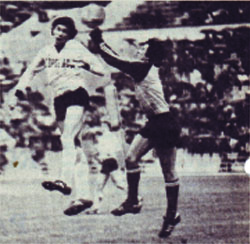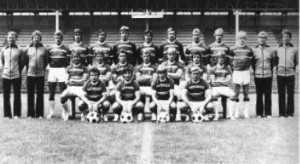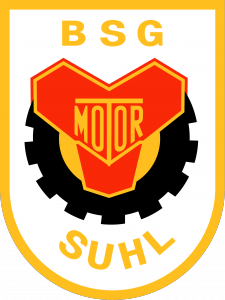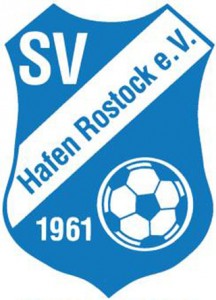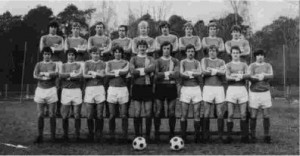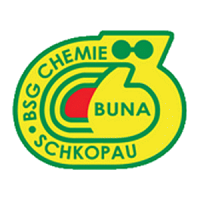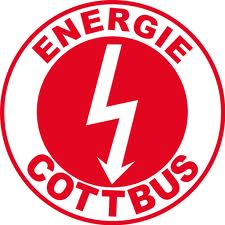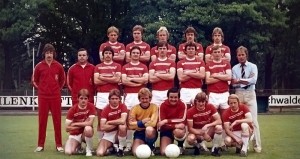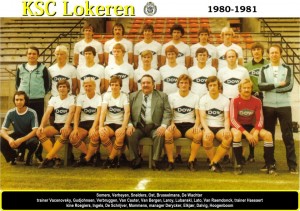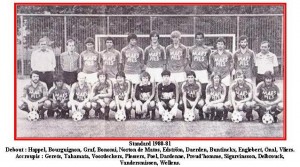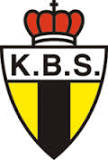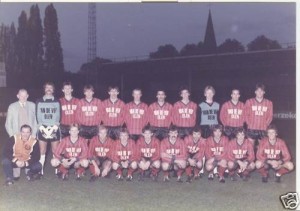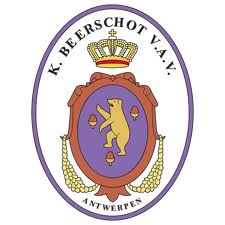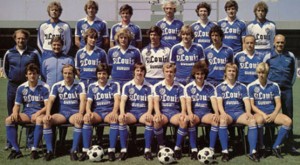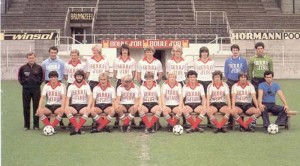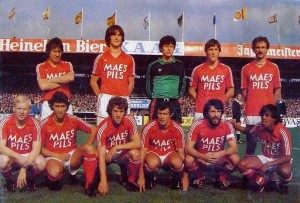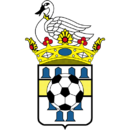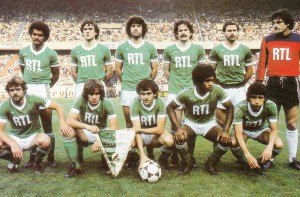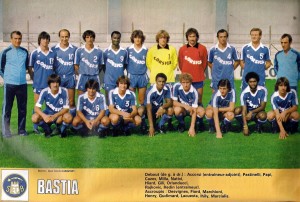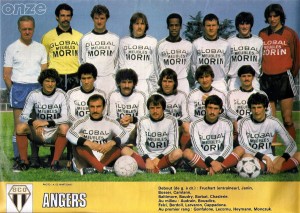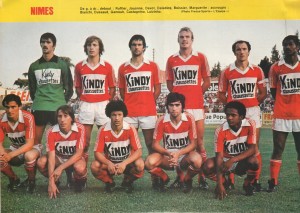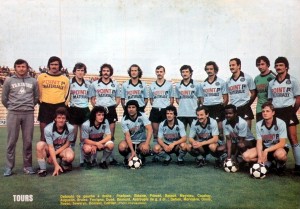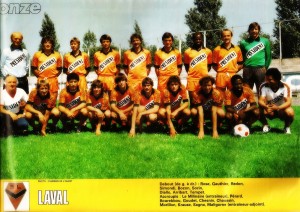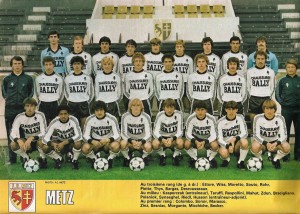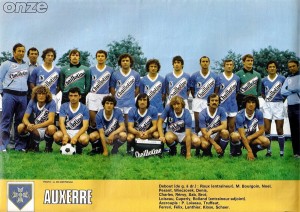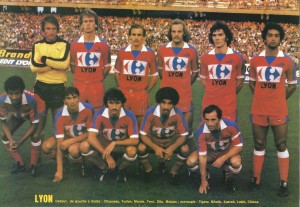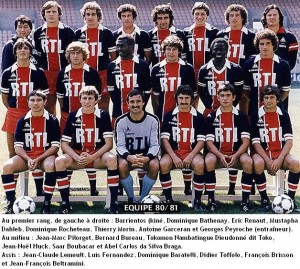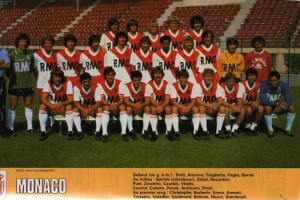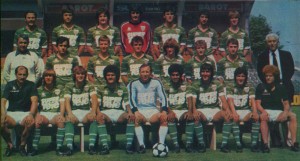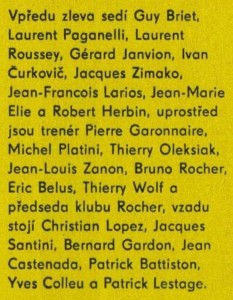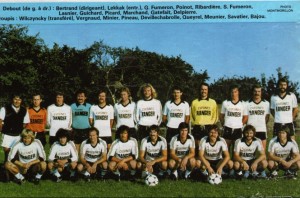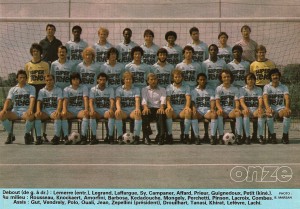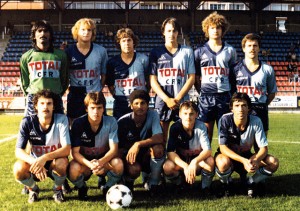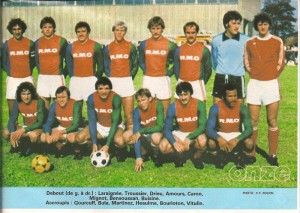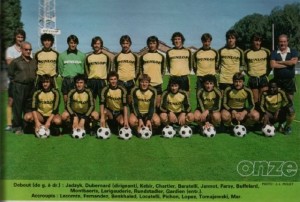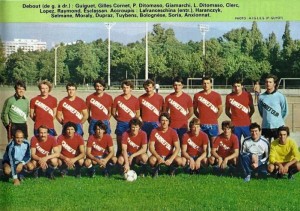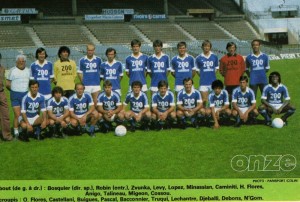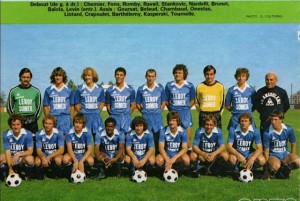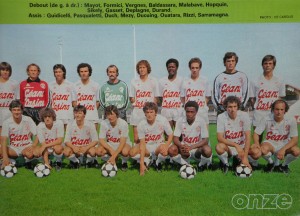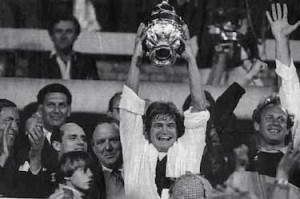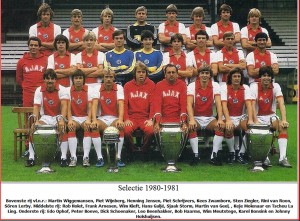The East German First Division was the same as ever – whatever different this season, it was only nuances. Four clubs made the outsiders group, but no big shake up – the better known clubs still survived: with 18 points each, BSG Sachsenring (Zwickau) and BSG Wismut (Aue) finished safely at 11th and 12th positions.
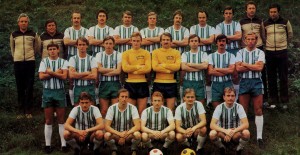
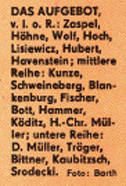 BSG Chemie (Bohlen) finished 14th and last with 16 points. It was expected – they were promoted for the first time in 1976-77, barely survived in their debut first division season, relegated 1978-79, promoted 1979-80. At most, Chemie was trying to become one of the ‘in-between’ clubs, but otherwise – prime candidate for relegation.
BSG Chemie (Bohlen) finished 14th and last with 16 points. It was expected – they were promoted for the first time in 1976-77, barely survived in their debut first division season, relegated 1978-79, promoted 1979-80. At most, Chemie was trying to become one of the ‘in-between’ clubs, but otherwise – prime candidate for relegation.
With 17 points BSG Stahl (Riesa) ended 13th and also relegated.
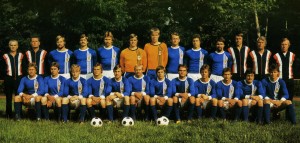
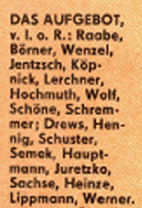 Same as Chemie (Bohlen) – true, they had longer and better first division history, but essentially ‘in-between’ club at best. Relegation was rather the rule, not the exception.
Same as Chemie (Bohlen) – true, they had longer and better first division history, but essentially ‘in-between’ club at best. Relegation was rather the rule, not the exception.
Five clubs were typically just mid-table clubs, not worrying about relegation, not thinking for a place higher than 5th.
 1.FC Lokomotive (Leipzig) had a relatively weak season, for they were normally among the best teams, but still they topped the mid-table teams, finishing 6th with 28 points.
1.FC Lokomotive (Leipzig) had a relatively weak season, for they were normally among the best teams, but still they topped the mid-table teams, finishing 6th with 28 points.
The names here were familiar, the same clubs year after year, with minor internal shuffling.
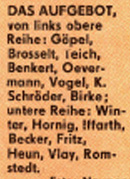 FC Rot-Weiss (Erfurt) finished 7th, which perhaps was a good season locally, but nationally – nothing suggested real improvement.
FC Rot-Weiss (Erfurt) finished 7th, which perhaps was a good season locally, but nationally – nothing suggested real improvement.
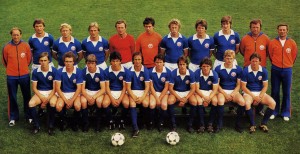 FC Hansa (Rostock) – 10th with 21 points – was a bit more interesting: the 1970s were terrible decade for them. They were promoted for N-tieth time the previous season and managed to survive. Not a great performance, but may the vicious circle ‘relegation-promotion-relegation’ was about to end.
FC Hansa (Rostock) – 10th with 21 points – was a bit more interesting: the 1970s were terrible decade for them. They were promoted for N-tieth time the previous season and managed to survive. Not a great performance, but may the vicious circle ‘relegation-promotion-relegation’ was about to end.
Well, when 9 of the league members are taken aside, only 5 remain – nothing new, such was the predicament of East German football. Lokomotive (Leipzig) was somewhat outside this group, but it was clear that the club suffered only a minor temporary slip. On the brighter side was FC Vorwarts (Frankfurt/Oder) – 31 points and 5th place.
 Once upon a time the Army club was the leading one in DDR, but their almost dominating years ended in the beginning of the 1970s, pretty much with their relocation from Berlin to Frankfurt/Oder. The club sunk to second division. In 1979-80 they won promotion and now they were not fighting for mere survival, but climbed high. It looked like Vorwarts was restoring its leading role, only they were at still early stage and better year was about to come. However, times changed… and Vorwarts was never to win a title again.
Once upon a time the Army club was the leading one in DDR, but their almost dominating years ended in the beginning of the 1970s, pretty much with their relocation from Berlin to Frankfurt/Oder. The club sunk to second division. In 1979-80 they won promotion and now they were not fighting for mere survival, but climbed high. It looked like Vorwarts was restoring its leading role, only they were at still early stage and better year was about to come. However, times changed… and Vorwarts was never to win a title again.
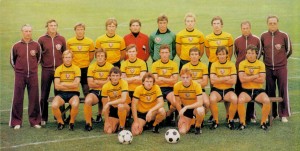 SG Dynamo (Dresden) was 4th , but it would be a mistake to say they were going down: perhaps a title contender this season, but solid as ever, losing bronze medals only on goal-difference. The team, however, was shaken by a scandal – it did not come to press coverage at the time, but in January 1991 three stars were arrested and brought to trial. Gerd Weber, Peter Cotte, and Matthias Muller were arrested at the airport, just before the DDR national team was leaving to tour South America – the players planned to escape to West, but were uncovered. Weber was sentenced 2 years and 3 months in jail, the other were not, but were expelled from Dynamo (Dresden), banned from the national team, and extended bans from playing any level of organized football – for DDR officially did not recognize professional sports – were slapped on them. Considering the tremors of such political scandal, Dynamo actually performed very well.
SG Dynamo (Dresden) was 4th , but it would be a mistake to say they were going down: perhaps a title contender this season, but solid as ever, losing bronze medals only on goal-difference. The team, however, was shaken by a scandal – it did not come to press coverage at the time, but in January 1991 three stars were arrested and brought to trial. Gerd Weber, Peter Cotte, and Matthias Muller were arrested at the airport, just before the DDR national team was leaving to tour South America – the players planned to escape to West, but were uncovered. Weber was sentenced 2 years and 3 months in jail, the other were not, but were expelled from Dynamo (Dresden), banned from the national team, and extended bans from playing any level of organized football – for DDR officially did not recognize professional sports – were slapped on them. Considering the tremors of such political scandal, Dynamo actually performed very well.
 1.FC Magdeburg (Magdeburg) ended with bronze medals, thanks to better goal-difference. Like all leading clubs, they maintained their class without any sign of erosion. About 8 former and current national team players here, lead by the top East German striker of the 1970s and one of the all-time best players, Joachim Streich, who was the top scorer of the league for a third time.
1.FC Magdeburg (Magdeburg) ended with bronze medals, thanks to better goal-difference. Like all leading clubs, they maintained their class without any sign of erosion. About 8 former and current national team players here, lead by the top East German striker of the 1970s and one of the all-time best players, Joachim Streich, who was the top scorer of the league for a third time.
FC Carl Zeiss (Jena) finished 2nd with 36 points: 2 points ahead of Magdeburg and Dynamo (Dresden), 3 points behind the champions. Best defensive record in the league – they allowed only 29 goals.
 Top row, from left: Dietmar Sengewald, Gerhard Hoppe, Hans-Ulrich Grapenthin, Detlef Zimmer, Rudiger Schnuphase.
Top row, from left: Dietmar Sengewald, Gerhard Hoppe, Hans-Ulrich Grapenthin, Detlef Zimmer, Rudiger Schnuphase.
Middle row: Hans Meyer – coach, Eberhard Vogel, Ulrich Oevermann, Andreas Bielau(?), Jurgen Raab, Martin, Topfer, Helmut Stein – assistant coach.
Front row: Wolfgang Schilling, Dieter Noack, Konrad Weise, Andreas Bielau(?), Lutz Lindemann, Jorg Burow.
On the surface – typical and no big deal: Carl Zeiss, like all the favourites, had a large number of former, current, and emerging stars, thus able to stay on top. An excellent international season, culminating at Cup Winners Cup final perhaps excused them from really competing for the title. But that was only on the surface – reality was already different, increasingly becoming whispered about: no matter how good were other teams, including Carl Zeiss, the title was reserved for only one club.
BFC Dynamo (Berlin) won its 3rd consecutive title with 39 points. They won 17 matches, tied 5 and lost 4. Goal-difference: 74-31, the only team scoring above 60 goals this year. Plain numbers tell all? On the surface, they did.
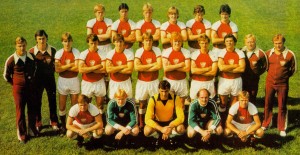 Champions again – three years in a row, and the future looking very bright:
Champions again – three years in a row, and the future looking very bright:
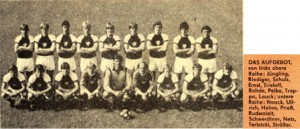
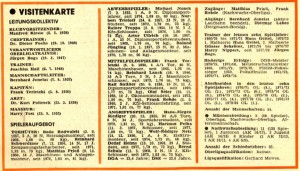 Looking at the squad, two things immediately bring attention: first, the team was very young, unlike the other leading clubs. With their average age of 23.4, these guys were going to be a factor for the next 10 years. Only 2 veterans – Reinhard Lauck and Frank Terletzki, and if Lauck was aproaching retirement, Terletzki seemingly was just arriving at his peak as a player. Second, these were the up and coming stars of East German football – apart from 2 veteran national team players, Lauck and Hans-Jurgen Ruidiger, the rest were just starting their national team career, but almost all of them already played for the other national team formations, those under 23. So much for purely football advantages. The real ones were outside the pitch, and by now at least in East Germany, people were not only suspecting – they were sure what was going on. Dynamo belonged to the Police and not even in a brod sense, but to the Secret Police, the ominous Stasi. Not only the club was able to get the top players – the Stasi ensured the success by clout, direct interference, and threats. After all, it was Stasi arresting and putting on trial the three stars of Dynamo (Dresden). It was clear that Stasi had a long-term intentions for its club and no matter what, Dynamo (Berlin) was designated winner for years to come – even the Army was unable to compete, Stasi ruled. So, no matter how good and promising this Dynamo squad looked like, their qualities really did not matter – they were going to win simply because Stasi ordered so.
Looking at the squad, two things immediately bring attention: first, the team was very young, unlike the other leading clubs. With their average age of 23.4, these guys were going to be a factor for the next 10 years. Only 2 veterans – Reinhard Lauck and Frank Terletzki, and if Lauck was aproaching retirement, Terletzki seemingly was just arriving at his peak as a player. Second, these were the up and coming stars of East German football – apart from 2 veteran national team players, Lauck and Hans-Jurgen Ruidiger, the rest were just starting their national team career, but almost all of them already played for the other national team formations, those under 23. So much for purely football advantages. The real ones were outside the pitch, and by now at least in East Germany, people were not only suspecting – they were sure what was going on. Dynamo belonged to the Police and not even in a brod sense, but to the Secret Police, the ominous Stasi. Not only the club was able to get the top players – the Stasi ensured the success by clout, direct interference, and threats. After all, it was Stasi arresting and putting on trial the three stars of Dynamo (Dresden). It was clear that Stasi had a long-term intentions for its club and no matter what, Dynamo (Berlin) was designated winner for years to come – even the Army was unable to compete, Stasi ruled. So, no matter how good and promising this Dynamo squad looked like, their qualities really did not matter – they were going to win simply because Stasi ordered so.
